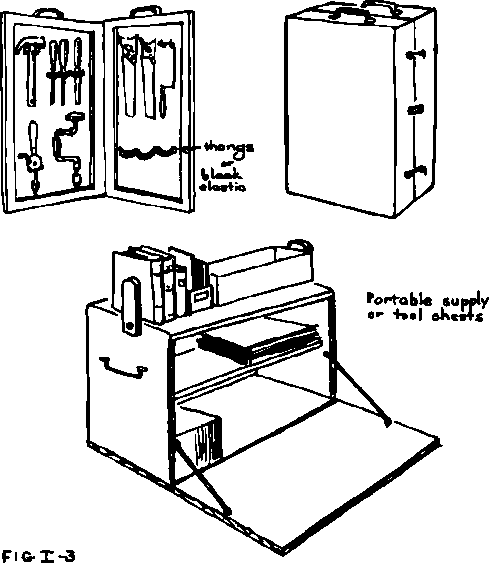Crafts In The Living Areas
Description
This section is from the book "Creative Crafts For Campers", by Catherine T. Hammett and Carol M. Horrocks. Also available from Amazon: Creative Crafts For Campers.
Crafts In The Living Areas
Arts and crafts in camp should not be confined to those projects that are carried out in the craft workshop or center. Some projects may, of necessity, be. worked upon in the center, where there may be special equipment or tools; but most camp handcraft projects are best carried out wherever activities go on, and the living place of tent or cabin is just such a place. It is important that counselors in tents, cabins, or units be aware of possibilities for good crafts, and be ready to encourage or stimulate creativity on the part of campers. Having some equipment and materials on hand in the unit hut, the junior camp center, or near tents and cabins will make it simple to start and carry out craft projects. Articles started in the craft workshop may be worked on or completed in the living unit, if there are general tools and some materials there for the campers' use.

The craft counselor may, as part of the planning for arts and crafts, supply each unit or section with a portable craft supply chest, or there may be a cupboard or chest in a lodge or gathering center which may be kept supplied. Some staff member in the living unit should be responsible for issuing such materials and supplies, for keeping the chest in order, and for requisitioning replenishments.
The contents of such a chest will be similar to those listed above for the general supply chest, though the supply will be much more limited, and will, to a certain extent, depend upon the emphases for the particular season. Thus, if the craft counselors hope to stimulate sketching, the unit supply chest should have paper, crayons, pencils, paints, brushes, and boards for group use. General contents may include: paper for various projects paints, crayons, etc. paste, rubber and household cement sharpening stones, oil, wax, sandpaper multipurpose saw at least one general reference book twine and cord thumbtacks, masking tape scissors nails, screws hammer, screwdriver stapler and staples can openers work gloves
Pocket Or Knapsack Crafts
Pocket or knapsack crafts are those projects that can be easily carried by the camper and worked on at any moment-while waiting one's turn at the camp shop, while singing outside the dining hall before a meal, while sitting around on tent floor or cabin step, during rest periods or quiet moments anywhere.
Braided' belts, whittling, sketching, equipment, and leather projects all lend themselves to this mobility. When counselors and campers alike have such handwork in evidence at all times, surely a good atmosphere of creativity exists in the camp. The conversations about what one is making, how one is doing, how each individual is working out a design or symbol or special pattern-all these make for good talk and good crafts. Counselors will find that the quiet moments they share with the shy or awkward camper in such pocket crafts will be rewarded with new opportunities for knowing the camper, for discovering needs and chances for leadership.
Initiating And Stimulating Activities
Not all campers know the enjoyment to be found in creating some craft article, but once introduced to the possibilities, they find adventure and satisfactions that open new horizons to them. Those campers who do know some of the possibilities will welcome suggestions for new steps and new ventures. Beginners need to be helped to start simply, so that they understand the medium and know some of the possibilities in its use before they can create an article. They should be encouraged to explore and experiment on their own to get the feel of the medium.
Program starts at the point of desire and interest of individuals, and the job of the staff is to help campers branch out from that point to new and interesting activities that will satisfy their desires, but also meet needs. Safety in the use of tools and materials will be a consideration of the counselor in the teaching of how to use and how to handle the specific equipment.
Of the many ways of motivating or stimulating activities, some have already been mentioned, such as the example set by interested staff members who have projects of their own. In The Camp Program Book there is a list of some ways to initiate activities (page 25) and further suggestions for stimulating arts and crafts (page 149). Here are a few suggestions, in brief:
Have exhibits of several types of finished articles in any field (not just one to copy). Have step-by-step exhibits of simple activities, so campers can follow without instruction.
Have bulletin boards that tell a story in colorful, pictorial fashion. Have progressive steps to help measure progress. Recognize each camper's work for what it is, rather than having awards. Make it the "thing to do" to participate in arts and crafts, and to individualize each project.
Above all, in stimulating and encouraging camper participation in arts and crafts activities, remember that what happens to the camper in the doing is what is important. Once having helped him to know the possibilities of the medium and the basic techniques in the field, let him explore, experiment, use his own ideas. Judge each camper's efforts in relation to his own level of skill and experience, not by an adult's level or the level of other campers. Encourage individual expression and achievement in performance.
Continue to:


